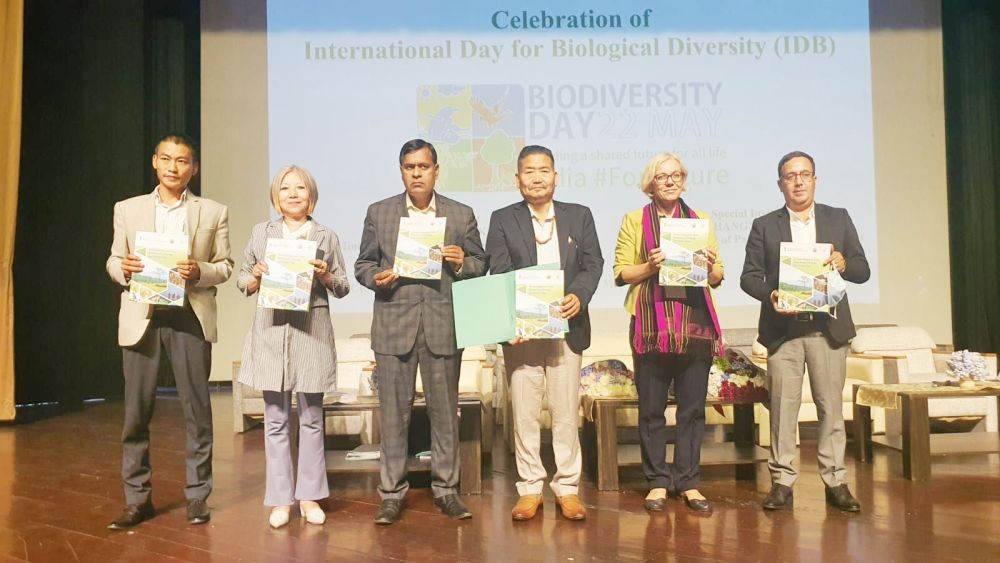Nagaland Minister, Yollow Konyak and other dignitaries during the launch of the Revised Nagaland State Biodiversity Strategy Action Plan on May 20.

Our Correspondent
Kohima | May 20
A revised Nagaland State Biodiversity Strategy Action Plan (NSBSAP) was today during the celebration of the International Day for Biological Diversity (IDB) 2022 at RCEMPA, Jotsoma.
The day was observed under the theme ‘Building a shared future for all life –India for Nature.’ It was jointly organised by Nagaland State Biodiversity Board (NSSB) and The Deutsche Gesellschaft fur Internationale Zusammenarbeit (GIZ).
The revised plan includes identification of twelve new Biodiversity Targets for the Nagaland based on the revised priorities underlined for the National Biodiversity Targets of 2008 (and the addendum in 2014) to form the National Biodiversity Action Plan (NBAP).
Each of these National Targets in turn has been derived in relation to global priorities underlined by the Aichi Targets and Sustainable Development Goals.
The timeline for moving towards achieving these targets have been kept at five years, with 2026 being the cut off year when it can be evaluated again.
Launching the plan, Minister for Forest, Environment and Climate Change, YM Yollow Konyak said that Nagaland harbours a large number of plant species which are endemic to the State or the North East part of India. He said that policy and planning mechanisms in every sphere of development should accommodate the aspect of biodiversity conservation.
He noted that India is one of 175 countries that are signatories of the Convention on Biological Diversity (CBD), and hence there is need to work together and establish certain policies and guidelines to achieve all the objectives of the convention while also protecting dwindling biodiversity resources.
All signatories of the CBD framed Strategies and Action Plans for obtaining the objectives of the. In 1999, the Ministry of Environment, Forest & Climate Change, Government of India prepared the national policy and macro level action strategies on biodiversity through a consultation process for effective implementation of the CBD.
As a follow up of the macro-level action strategies on biodiversity, detailed action plans on biodiversity were made at the national level and state level. The National Biodiversity Strategy and Action Plan was prepared in 2008. The Department of Environment, Forest & Climate Change and the Centre of Environment Studies, North Eastern Hill University (NEHU), Shillong in 2005, jointly prepared the state level Biodiversity Strategy and Action Plan for Nagaland.
The Minister stated that the Nagaland Biodiversity Strategy and Action Plan were revised with the financial support of the GIZ and with technical support of the Foundation for Ecological Security (FES).
Earlier, the keynote address was delivered by Satya Prakash Tripathi, IFS (Retd), Chairman, Nagaland State Biodiversity Board. Farhad Vania, Country Office, GIZ, India; Dr Antje C Berger, Counsellor, Head of Environmental Affairs, German Embassy, New Delhi; and James Pangsang Kongkal Sangma, Minister for Forest, Environment and Climate Change, Meghalaya also delivered speeches.
It may be noted that Nagaland observed the International Day for Biological Diversity today, against the normal day as May 22 falls on a Sunday.
12 Nagaland Biodiversity Targets (NBT):
• Create awareness among significant proportion of population of the values of biodiversity and steps taken to conserve and use it sustainably.
• To integrate values of biodiversity into state planning processes, development programmes and poverty alleviation strategies.
• Strategies for reducing rate of degradation, fragmentation and loss of all natural habitats are finalized and actions put in place for environmental amelioration and human well being.
• Invasive species and pathways are identified and strategies to manage them developed.
• Measures are adopted for sustainable management of agriculture, forestry and fisheries.
• Ecologically representative areas under terrestrial and inland water, those of particular importance for species, biodiversity and ecosystem services, are conserved effectively and equitably.
• Genetic diversity of cultivated plants, farm livestock, and their wild relatives, including other socio - economically as well as culturally valuable species is maintained, and strategies have been developed and implemented for minimizing genetic erosion.
• Ecosystem services, especially those relating to water, human health, livelihoods and well being, are enumerated and measures to safeguard them are identified, taking into account the needs of women and local communities, particularly the poor and vulnerable sections.
• Access to genetic resources and the fair and equitable sharing of benefits arising from their utilization as per the Nagoya Protocol are operational, consistent with national legislations.
• Effective, participatory and updated National Biodiversity Action Plan is made operational at different levels of governance.
• State wide initiatives using communities' traditional knowledge relating to biodiversity are strengthened, with a view to protecting this knowledge in accordance with national legislations and international obligations.
• Opportunities to increase the availability of financial, human and technical resources to facilitate effective implementation of the strategic plan and state targets are identified and the strategy for resource mobilization is adopted.
(All these targets are to be achieved by 2026)



.jpg)


